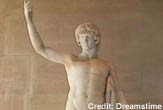Why Ancient Greeks are Always Nude

Male nudes are the norm in Greek art, even though historians have stated that ancient Greeks kept their clothes on for the most part. New research suggests that art might have been imitating life more closely than previously thought.
Nudity was a costume used by artists to depict various roles of men, ranging from heroicism and status to defeat.
"In ancient Greek art, there are many different kinds of nudity that can mean many different things," said Jeffrey Hurwit, an historian of ancient art at the University of Oregon. "Sometimes they are contradictory."
Hurwit's newly published research shows that the Greeks did walk around in the buff in some situations. Men strode about free of their togas in the bedroom and at parties called symposia, where they would eat, drink and carouse. Nudity was also common on the athletic fields and at the Olympic games. (Because there are so many images of Greek athletes, some lay people have assumed the Greeks were in their birthday suits all the time.)
Battling nudity
However, nudity was often risky for the Greeks.
"Greek males, it is generally agreed, did not walk around town naked, they did not ride their horses naked, and they certainly did not go into battle naked," Hurwit said. "In most public contexts, clothing was not optional, and in combat nakedness was suicidal."
Sign up for the Live Science daily newsletter now
Get the world’s most fascinating discoveries delivered straight to your inbox.
Warriors and heroes are often, but not always, represented in the nude. Artists demonstrated the physical prowess men used to defeat their enemies. But, as Hurwit said, if you can go into battle naked, you've got to be pretty good.
However, heroes weren't the only men disrobed by ancient artists.
Here's looking at you
Hurwit's research, published in the Jan. issue of the American Journal of Archaeology, also found examples of defeated, dying and dead naked men. In these cases, nudity was chosen to represent the subjects' vulnerabilities.
Meanwhile, common laborers were also drawn undressed, illustrating their sweat and muscles to show how hard they worked. Gods and people of higher social class were sometimes—but not always—depicted in the buff to demonstrate their place in society.
Hurwit's research of these nuances of Greek art also offers a glimpse into the cultural source of our civilization today.
"We can try to understand ourselves and our conception of what it means to be a hero and to exceed normal expectations," Hurwit told LiveScience. "The more we know about other cultures, the deeper we will be able to understand our own culture and ourselves."









